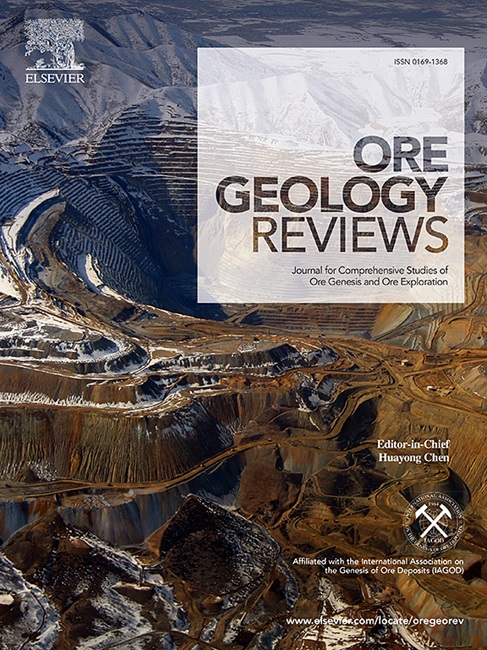Molybdenite Re-Os geochronology, pyrite in-situ trace element and sulfur isotope analysis of the Haigou gold deposit, Northeast China: Implications for the genesis of an intrusion-related lode gold deposit
IF 3.2
2区 地球科学
Q1 GEOLOGY
引用次数: 0
Abstract
The Haigou gold deposit (>40 tons Au), situated in eastern Jilin Province within the northeastern segment of the North China Craton (NCC), is one of the largest gold deposits in Northeast China. Hosted within a Paleozoic granitoid stock, the deposit undergoes four successive hydrothermal stages: (1) the pre-ore quartz-K-feldspar stage, (2) the early syn-ore quartz-pyrite stage, (3) the late syn-ore quartz-polymetallic sulfide-gold stage (the main ore-forming stage), and (4) the post-ore carbonate-quartz stage. To constrain the genesis of gold mineralization at Haigou, we conducted molybdenite Re-Os dating and in situ trace element and sulfur isotope analyses using laser ablation–inductively coupled plasma–mass spectrometry (LA-ICP-MS). Three generations of pyrite are identified based on their textural and geochemical characteristics. Py1 (Stage I) occurs as euhedral grains with low trace element concentrations. Py2 (Stage II) displays dissolution textures and fragmented grains with distinct Co and Ni zoning patterns. Py3 (Stage III), co-precipitated with galena, chalcopyrite, and visible gold, is enriched in Au, Ag, Cu, Pb and Te, indicating crystallization from a metal-rich ore fluid. The geochemical trends observed provide valuable insights into the oxygen fugacity (fO2) changes that controlled metal precipitation and pyrite formation throughout the evolution of the Haigou deposit. Sulfur isotope analyses show that the three pyrite generations have δ34S values varying between −13.32 ‰ and 0.86 ‰, suggesting a primarily magmatic sulfur source with possible modification in an oxidizing environment. Combined LA-ICP-MS trace element data and sulfur isotope signatures indicate that the Haigou granitoid stock was the primary source of gold in the hydrothermal system. A molybdenite Re-Os age of 309.5 ± 4.1 Ma (weighted mean) constrains gold mineralization to late Paleozoic magmatism, coinciding with the subduction of the Paleo-Asian Ocean beneath the North China Block. Integrating geological, geochemical, and geochronological evidence, we classify the Haigou deposit as an intrusion-related lode gold system, representing a significant episode of late Paleozoic gold mineralization along the eastern margin of the Central Asian Orogenic Belt (CAOB) and NCC.

海沟金矿辉钼矿Re-Os年代学、黄铁矿原位微量元素及硫同位素分析:对侵入岩型脉状金矿床成因的启示
海沟金矿床位于吉林省东部,位于华北克拉通东北段,是中国东北地区最大的金矿床之一,含金40吨。矿床赋存于古生代花岗岩中,经历了4个连续的热液阶段:(1)成矿前石英-钾长石阶段,(2)早期同矿石英-黄铁矿阶段,(3)晚期同矿石英-多金属硫化物-金阶段(主要成矿阶段),(4)成矿后碳酸盐-石英阶段。为了确定海沟金矿化成因,采用激光烧蚀-电感耦合等离子体质谱(LA-ICP-MS)技术对辉钼矿Re-Os定年、原位微量元素和硫同位素进行了分析。根据黄铁矿的结构和地球化学特征,确定了三代黄铁矿。Py1 (I期)以低微量元素浓度的自面体颗粒出现。Py2 (II期)表现为溶蚀织构和破碎颗粒,具有明显的Co和Ni分带模式。Py3 (III期)与方铅矿、黄铜矿和可见金共析出,富集Au、Ag、Cu、Pb和Te,为富金属矿液结晶。观测到的地球化学趋势为研究在海沟矿床演化过程中控制金属沉淀和黄铁矿形成的氧逸度(fO2)变化提供了有价值的见解。硫同位素分析表明,3代黄铁矿的δ34S值在−13.32‰~ 0.86‰之间,表明其硫源主要为岩浆,可能在氧化环境下发生了变质。LA-ICP-MS微量元素数据和硫同位素特征表明,海沟花岗岩类矿床是热液体系中金的主要来源。辉钼矿Re-Os年龄为309.5±4.1 Ma(加权平均),限制了金成矿作用于晚古生代岩浆活动,与华北地块下古亚洲洋的俯冲作用相吻合。综合地质、地球化学和年代学证据,将海沟矿床划分为一个与侵入体有关的矿脉金系统,代表了中亚造山带东缘和NCC晚古生代的一次重要金矿化事件。
本文章由计算机程序翻译,如有差异,请以英文原文为准。
求助全文
约1分钟内获得全文
求助全文
来源期刊

Ore Geology Reviews
地学-地质学
CiteScore
6.50
自引率
27.30%
发文量
546
审稿时长
22.9 weeks
期刊介绍:
Ore Geology Reviews aims to familiarize all earth scientists with recent advances in a number of interconnected disciplines related to the study of, and search for, ore deposits. The reviews range from brief to longer contributions, but the journal preferentially publishes manuscripts that fill the niche between the commonly shorter journal articles and the comprehensive book coverages, and thus has a special appeal to many authors and readers.
 求助内容:
求助内容: 应助结果提醒方式:
应助结果提醒方式:


